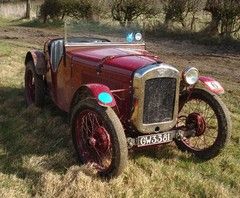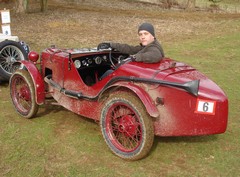PistonHeads Goes Vintage Trialling
We experience the mud and glory of trialling in a pre-war car. OK, not the glory...
Here at PistonHeads we like to think that we're a broad minded bunch. We have wide ranging tastes in cars, as do our members, but we're united by one thing; a love for and fascination with all things motoring. So when PH was offered the chance to take part in a classic trials event, we jumped at the opportunity. It turned out to be quite a day; a car with a laughably small engine which turned out to be an absolute hoot, a couple of deeply scary moments and mud. A lot of mud.
So what is trialling? Like many forms of motor sport below the high profile (and big money) track based series, trialling is followed by a relatively small but resolutely hardcore bunch. Like most such disciplines it seems at first glance to be simple and, dare I say it, unsophisticated. Wrong on both counts; this is a sport requiring real skill, deftness of touch, engineering ingenuity and no small measure of mechanical sympathy. Oh, and no fear. Blind faith in your car's ability to tackle the seemingly impossible is a bonus too.
With its roots going back to the 1930s the basic principles of classic trialling are simple; these events are tests of both vehicle, driver and passenger, usually over a 70-100 mile road route punctuated by observed off road sections. Designed to take the car to the limit of its capabilities, a typical section involves a steep short hill or track where no production vehicle would normally venture. The aim is to 'clear' the section - to keep the car moving through a combination of throttle, clutch and 'bouncing' the car to eke out grip in conditions where there would seem to be none. Bouncing is necessary to shift as much weight on to the back (driven) axle, and is the only competitive motor sport where being a bit of a fat bloke is positively encouraged.
Team PH (actually me and mate/race preparation guru Patrick Blakeney-Edwards) were taking part in the Falcon Motor Club's March Hare Trial, set over 90 miles and 15 sections in Bedfordshire/Hertfordshire. Our ride for the day was a 1930 Austin Seven Ulster rep. A pretty and recently restored car with performance statistics that hardly look blistering on paper; 747cc, 3 speed 'box and a swooping (for an Austin Seven) body style that belies really rather modest performance. Add in two un-waif like blokes and a total mileage since restoration of 2, and it didn't look hopeful. I've 'bounced' for Patrick on plenty of Vintage Sports Car Club trials, but this was my first time behind the wheel and the little car's first competitive outing.
An early start at scrutineering control saw team PH concentrating on the important things in life - namely bacon buttie and mug of tea procurement. Duly armed, we put our little car through the rigorous testing process needed to be let loose on the road. Apparently our fire extinguisher was slightly too small and there was much sucking of air through teeth about various under bonnet matters, but nothing to prevent us being released as part of the first group in two minute intervals, our time being 8:40am.
On the road the Seven is actually surprisingly agile. Just as in any low, open car the sensation of speed is readily achieved - our car has an open drive shaft (thank god I'm wearing loafers - a stray lace at 7500rpm would be no fun) and whilst the gear change needs a good dose of revs on the down shift (no synchro, and DSG wasn't an option back then), I soon get the hang of it and we're making good progress. We've even got brakes - a pleasant surprise, as most vintage car drivers will attest. Our group consists of a handful of other Sevens, and so strong is our pace that we've overtaken most of our group before the first section. Buoyed with confidence in our car's abilities and relief at our ability to navigate using the (excellent) route book, pretty soon the first of 15 sections looms into view.
As with all motor sport, preparation is key and every section involves a subtle transformation from road to off-road mode. It's crucial to maximise grip on a section so the tyres lose around 30 psi, we also lower the windscreen for added visibility and that's it - ready for the off. Our engine is small but newly restored and perfectly balanced. Dial in more revs than you'd think possible (or safe) in such an old car, hold the thing on the handbrake, wait for the nod from the marshal and we're off. And then we bog down completely. Not good. I've discovered the hard way that two things that are crucial for trials success in a small car; keep your foot in as hard as possible, and hold your nerve. Over the next two sections I keep making the same mistake - the car will rev to around 7000 rpm with ease (although with no working rev counter we can only guess) but the power is right at the top of the rev range and I soon discover that the trick is to 'give it death in 1st' and keep it there whilst concentrating on finding whatever grip the section can offer.
By section 5, I'm really starting to crack it, and having huge fun in the process. I've cleared a couple of sections, although possibly more by luck than judgement, and I'm really learning from my mistakes. We've realised a couple of things that the car needs - definitely a lower ratio differential for starters, and possibly a lower pie count for driver and navigator. Our road pace against the other cars in our group is pointless on a trial where all points are awarded for mechanical grip on slippy off road sections, and we watch other Sevens roll off the top of sections without seeming to need our maximum attack approach.
The Falcon MC chaps have put a great deal of effort into providing a really mixed bag of surfaces and sections to test the cars. Taking place roughly between the A5 at Luton in Bedfordshire and the Brickhills, the route provides surfaces as diverse as chalky, dry and super steep woodland mud punctuated with axle breaking and puncture inducing tree roots (check out the video - it isn't a chainsaw that you can hear, it's me at what passes for full pelt), and technical exposed sandy sections where we did particularly well until I failed to notice that we had driven into a foot high mound of soil and proceeded to set fire to the clutch.
Our fellow competitors are trialling in a diverse range of machinery. There are trials specials such as Dellows and Lieges, purpose built for just this sort of sport and driven by similarly precisely clothed and prepared drivers, and a smattering of vintage stuff such as ours. What really caught my attention though were the production cars such as Pug 205s or even a Skoda Estelle (I found myself coveting one of the latter - an entirely new experience) with subtle modifications to enhance fitness for purpose; jacked up rear suspension for ground clearance, stripped out interiors and the addition of prominent and hardy towing points for the inevitable rescue when things get too sticky. I've also discovered where all the Suzuki XC90s went; they're being trialled, apparently.
As the day wore on inclement weather arrived, and with it the realisation that vintage motoring can be cold, wet and frankly bloody painful for the bald driver when it sleets. I discovered two things about driving through sleet at 50mph in an open topped car; firstly that a peaked cap is essential kit if one is to have any chance of seeing where one is going or other vehicles, and secondly that I did not appear to be in possession of a peaked cap. Bugger. Success in motor sport is about strategy and the ability to adapt to changing circumstances, and at this point sporting director Blakeney-Edwards decided that respite from the weather in the form of a country pub, a pint of IPA and a sausage bap would be good for morale and our chance of finishing without hypothermia. Sensible bloke.
The discomfort and rain soon passed however and, after a particularly challenging woodland section in which navigator Blakeney-Edwards finally conceded that he was too fat to be of much use on a muddy section and climbed out to take some photos, it was time to return to base. All day we'd noticed that the car tended to move around at the rear above 35mph (which, with engine singing at 7000rpm+ and the road clearly visible through the floor, felt twice as quick) and on the way home we discovered the cause. Rounding a reasonably quick downhill bend, a sudden clunk signalled the departure of our left offside wheel, which carried on for a few hundred metres before embedding itself in a bush. The beauty about an Austin Seven is that it is light and reasonably robust however, and despite a 100m scrape of the rear drum against tarmac bearing 200kg of slightly panicky crew, the car was none the worse for wear. With Blakeney-Edwards supporting the car Bruce Banner style, I relocated the wheel and off we went.
So what was the end result of all this slightly baffling (to the outside at least) Motor Sport? My ineptitude, a laissez-faire attitude to completing all of the sections and some stiff and experienced competition ensured that we didn't trouble the silverware, but we had great fun and learned how to make the car more competitive for its next outing. It needs a lower ratio diff to harness what power the engine has, and I've learned how to drive it hard. Huge thanks go to the organisers and marshals of the Falcon MC for putting on such a great event. We'll be back next year for sure, this time with peaked cap, low ratio diff and fully tightened wheel nuts...
PH thanks:
The organisers and marshalls at Falcoln Motor Club
Images: Dave Cook and Mike Leet
Gassing Station | General Gassing | Top of Page | What's New | My Stuff









